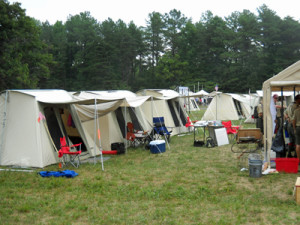Canvas tents are a great choice if you want a rugged and durable product.
Canvas tent fabric has a number of unique advantages over polyester.
Its hard-wearing properties, and serviceabilty as a 4 season tent, are the reasons many buyers choose canvas fabric over polyester.
Modern canvas material also has other benefits:
- Because they are heavier and have more substance, canvas tents are better suited for extended camping trips.
- They are able to be manufactured in a cabin tent style, which allows for sturdy straight walls. There is more room to move about inside.
- These tents generally have more head room, so no need to continually stoop.
- Canvas fabric is better able to cope with rough winter weather.
- They are a 4 season tent well suited also to summer camping because canvas breathes better than polyester.
- If you choose canvas, it will be many years/decades before you need to think of a replacement.
The two standout disadvantages of canvas are its higher price and extra weight, which makes it a little more difficult to transport.
Even though they are heavier than polyester tents, they are not as weighty as the canvas tents of the past.
It is also more bulky, so does not pack down as conveniently as polyester/nylon tents.
What are the properties of canvas fabric that make it so suitable for camping tents?
- Cotton is essentially the backbone of canvas, and has been for generations.
- In fact, for seniors like me, it is a memory of early family camping trips with heavyweight, unwieldy canvas tents, that have made us avoid getting involved with canvas again.
- But these days, top grade canvas is often made of polyester/cotton blend.
- This utilizes the good attributes of both these materials and reduces the negatives.
- The cotton-based material gives it superior ability to breathe and the facility to seal really well and be water tight.
- Cotton by itself is not as strong compared to the various forms of polyester fabric in the same gauge. That’s the reason the old style canvas tent fabric had to be woven so heavily.
- Polyester by itself has superior strength to weight ratio, which results in stronger, lighter tents.
- But polyester alone does not breathe nearly as well as canvas, which leads to issues with condensation and poor temperature control.
- Unlike canvas, polyester will not contract around the stitching points, which then become prone to leaking.
Why you need to take steps to prepare your new canvas tent before its first camping trip?
Even the best canvas fabric is not water proof to its full potential. Although near impossible to see with the naked eye, the holes left by the sewing needle are slightly larger than the thread passing throught it.
This leaves a point vulnerable to leaking. But the poly/cotton thread used to join the cotton, or poly/cotton blend canvas fabric, has the properties for self-sealing.
If you follow the recommendations, the thread will expand and the canvas shrink to make the sewing holes impervious to water.
These tents, for the most part, do not need special treatment after purchase. But you are advised to follow a few basic steps to ensure you stay dry while camping.
We suggest that you check first with the manufacturer whether or not your tent has been waterproofed.
This is how to weatherproof your new canvas camping tent.
- Your tent needs to be “weathered”, and this is achieved by repeating a wetting and drying process.
- Pitch the tent, then spray it with water from a hose and let it dry. Repeat this a few times.
- You could do this by leaving the tent out in the rain a number of times. The hose is more convenient, but make sure you set the nozzle to a gentle spray.
- By doing this, the poly/cotton thread stitching will expand, while the canvas fabric shrinks up to around four per cent.
- If you have the opportunity to set up at home during constant rain, this might be more beneficial in soaking areas of the tent fabric which have multi layers. This includes spots like reinforced corners or where edges are folded over.
- Don’t panic if there is some dripping from the joins. These areas will leak until the canvas fabric has a chance to dry off.
- If your tent is used primarily in hot and dry weather over a number of years, and not been subject to any wetting in this period, this weathering process will have to be repeated.
It might take a decade of constant use, but the tent will eventually need re-waterproofing.
Look for the signs that tell you whether you need to take steps to make your tent more waterproof.
This will be apparent when water starts leaking through the canvas fabric itself, not just the seams.
You will most likely notice wet spots staying after the rain has ceased.
The canvas will give you a sort of dry and dusty feel to the touch.
Pays to buy a quality water proofing agent.
This is usually in the form of a water-based sealant, and is available in cans from camping stores.
The sealant is painted on and dries to a clear finish.
Make sure the sealant is of a thin consistency so that when you paint it on, it will soak right in.
Use the recommended thinner, if required.
Don’t paint on if if it feels like you are applying a thick surface paint.
Before you begin the reproofing process, make sure you have a clean surface and treat any mold.
Otherwise the reproofing will lock in the dirt and mold.
Do regular basic maintenance of your canvas tent fabric and get decades of reliability.
Follow these canvas care tips:
- Ideally, begin by cleaning your tent at the campsite before packing it up.
- Use a soft brush or broom to remove, dust, dirt and minor stains. Don’t get too rough with the canvas.
- Hose down the tent with cold water, if possible.
- For bird droppings and other stubborn to remove material, use very hot water. This will slacken the weave in the canvas tent.
- Use an old toothbrush for bird droppings, but remember not to scrub too hard.
- Never resort to detergents, soaps or bleach. This will almost certainly affect the waterproofing and coloring of the tent.
- Don’t use high pressure spray devices. They can leave an unwelcome trail in the canvas as the waterproofing and color are scoured away.
- Whenever possible, ensure your tent is dry before packing up at the campsite.
- If you must pack up a wet or just damp tent, ensure it is thoroughly aired and dried within the following 24 to 48 hours.
- Once home, set up the tent, hang it up, or lay it out to dry. Set it up even if it is still raining, then pack it away once it has a chance to completely dry, after the rain has passed.
- Never store wet canvas because this leads to mold growth.
- At the first sign of mold or mildew, hose it and wipe it down before it gets a chance to grow into the fabric.
- Never store canvas tents directly on concrete surfaces. This encourages mold and insect infestation, as well as having the potential for a harmful acidic effect.
Take care of the canvas tent fabric, but don’t forget the zippers.
Faulty zips can become a big headache. It could hinder entry and exit, also compromise tent ventilation. So include them in your general tent maintence.
If allowed to deteriorate too far, it could lead to costly repairs.
Keep zips clean and have them closed when putting up or dismantling your tent..
A good silicone spray is recommended to keep them lubricated
Avoid oil-based lubricants because they will attract dirt and grit, which will wear out the zipper a lot faster than normal.
Never force a zip, and never zip over wet or dried mud.
A warn slider will sometimes present itself by teeth not meeting up correctly.
A slider can be replaced. But if you are still at the campsite, try a little “first aid” by using a pair of pliers to squash the slider slightly (very slightly, mind).
Remember, this is a temporary fix only. Don’t leave the proper replacement too long.
Preferably, don’t let it get to this stage, because the canvas will need to be placed under a machine to restitch the unpicked area to install the new zip.
If you have have read right down to here, it might appear a big task to look after canvas. But all these steps are pretty basic. You just need to avoid putting off the job once you arrive home from your camping trip, and next time out have the reassurance you are unpacking a clean. water tight and durable canvas tent.
Canvas tents remain a top choice for family camping. Just click here for our review of the popular Kodiak Canvas Flex-Bow Tent, a 4 season tent.



1 comment for “Maintaining Canvas Tent Fabric”